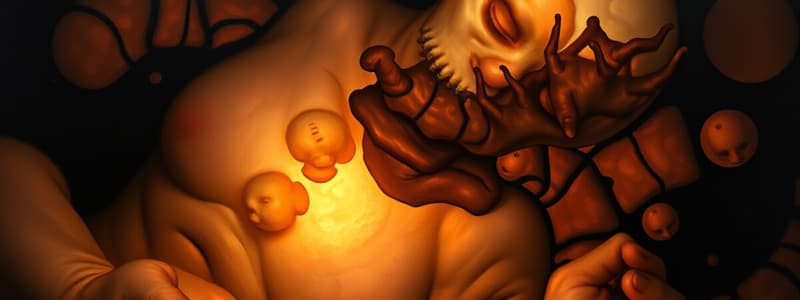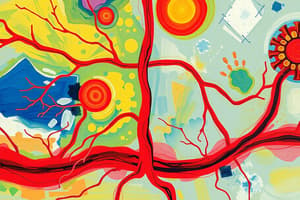Podcast
Questions and Answers
What type of muscle is primarily responsible for the milking action of the root of the tongue?
What type of muscle is primarily responsible for the milking action of the root of the tongue?
- Cardiac muscle
- Skeletal muscle (correct)
- Smooth muscle
- Striated muscle
Which main function is associated with the rhythmic contraction of smooth muscle walls in vessels?
Which main function is associated with the rhythmic contraction of smooth muscle walls in vessels?
- Milking action
- Voluntary movements
- Breathing movements (correct)
- Digestive processes
What anatomical feature surrounds the openings of the auditory tubes into the pharynx?
What anatomical feature surrounds the openings of the auditory tubes into the pharynx?
- Pharyngeal tonsils
- Tubal tonsils (correct)
- Palatine tonsils
- Lingual tonsils
Which set of tonsils is NOT mentioned as one of the three main sets?
Which set of tonsils is NOT mentioned as one of the three main sets?
What action does the skeletal muscle perform in relation to the root of the tongue?
What action does the skeletal muscle perform in relation to the root of the tongue?
Which of the following best describes the relationship between the tonsils and the auditory tubes?
Which of the following best describes the relationship between the tonsils and the auditory tubes?
What is a defining characteristic of lymphangioma circumscriptum?
What is a defining characteristic of lymphangioma circumscriptum?
What is the primary reason for the development of cavernous lymphangiomas?
What is the primary reason for the development of cavernous lymphangiomas?
Which of the following treatments is NOT mentioned for managing lymphangiomas?
Which of the following treatments is NOT mentioned for managing lymphangiomas?
How does the lymphatic system primarily differ from the circulatory system?
How does the lymphatic system primarily differ from the circulatory system?
What is the primary function of lymphoid tissue in the body?
What is the primary function of lymphoid tissue in the body?
Which of the following components is absent in lymphatic capillaries?
Which of the following components is absent in lymphatic capillaries?
What function does the lymphatic system serve in the body?
What function does the lymphatic system serve in the body?
What is the approximate amount of interstitial fluid that the lymphatic system returns to the blood daily?
What is the approximate amount of interstitial fluid that the lymphatic system returns to the blood daily?
What type of white blood cells are primarily produced in lymphatic tissue rather than bone marrow?
What type of white blood cells are primarily produced in lymphatic tissue rather than bone marrow?
Which area is least likely to be associated with lymphangioma circumscriptum?
Which area is least likely to be associated with lymphangioma circumscriptum?
What is the approximate size range of lymphatic capillaries?
What is the approximate size range of lymphatic capillaries?
What characteristic of lymphatic endothelial cells helps to anchor them to surrounding tissues?
What characteristic of lymphatic endothelial cells helps to anchor them to surrounding tissues?
In the lymphatic system, what is lymph primarily composed of?
In the lymphatic system, what is lymph primarily composed of?
Which feature describes the appearance of lymph after a meal?
Which feature describes the appearance of lymph after a meal?
What outcome results from the failure of proper connections in the lymphatic system?
What outcome results from the failure of proper connections in the lymphatic system?
Which of the following is a main role of white blood cells in the body?
Which of the following is a main role of white blood cells in the body?
What component is generally missing from lymphatic capillaries?
What component is generally missing from lymphatic capillaries?
Which part of the body contains no lymphatic capillaries?
Which part of the body contains no lymphatic capillaries?
How much of the impurities does reticular cells in lymph nodes typically remove?
How much of the impurities does reticular cells in lymph nodes typically remove?
What is the primary function of the tonsils?
What is the primary function of the tonsils?
Which epithelium type covers the lymphoid tissue of the tonsils?
Which epithelium type covers the lymphoid tissue of the tonsils?
What is a characteristic feature of the tonsils?
What is a characteristic feature of the tonsils?
What differentiates palatine tonsils from other tonsil types?
What differentiates palatine tonsils from other tonsil types?
What is the lymphatic flow pathway leading to the circulatory system?
What is the lymphatic flow pathway leading to the circulatory system?
What is the nature of the lymphatic system?
What is the nature of the lymphatic system?
Where are the pharyngeal tonsils located?
Where are the pharyngeal tonsils located?
What causes tonsillitis most commonly?
What causes tonsillitis most commonly?
What characterizes the pressure gradient in the lymphatic system?
What characterizes the pressure gradient in the lymphatic system?
What is the primary function of the right lymphatic duct?
What is the primary function of the right lymphatic duct?
Which lymphatic trunk does NOT drain into the thoracic duct?
Which lymphatic trunk does NOT drain into the thoracic duct?
At which level does the thoracic duct cross to the left side of the body?
At which level does the thoracic duct cross to the left side of the body?
Where does the right lymphatic duct empty lymph?
Where does the right lymphatic duct empty lymph?
What region does the thoracic duct primarily drain?
What region does the thoracic duct primarily drain?
Which statement accurately describes the relative size of the right lymphatic duct compared to the thoracic duct?
Which statement accurately describes the relative size of the right lymphatic duct compared to the thoracic duct?
Which lymphatic trunk does NOT contribute to the collection of lymph for the right lymphatic duct?
Which lymphatic trunk does NOT contribute to the collection of lymph for the right lymphatic duct?
What is the primary drainage route for the thoracic duct?
What is the primary drainage route for the thoracic duct?
What does the thoracic duct primarily drain?
What does the thoracic duct primarily drain?
Flashcards are hidden until you start studying
Study Notes
Lymphangioma Circumscripta
- Microcytic lymphatic malformation; appears as clusters of small, firm blisters filled with lymph fluid.
- Commonly found on the neck, underarm, and tongue.
- Management options include surgical excision, radiation therapy, sclerotherapy, and the use of OK-432.
Overview of the Lymphatic System
- Comprising tissues, organs, and vessels, the lymphatic system maintains the body’s fluid balance and protects against pathogens.
- Functions similarly to the circulatory system but is a one-way system; lymph does not circulate in loops like blood.
- Collects interstitial fluid (2-4 liters/day) from tissues and delivers it to the bloodstream.
Hemopoiesis
- Reticular cells in lymphatic nodes remove approximately 99% of impurities.
- Certain white blood cells (lymphocytes, monocytes) are produced in lymphatic tissue rather than bone marrow.
Body Defense and Immunity
- Lymphoid tissue is integral to the immune system, offering diffuse surveillance across body tissues and organs.
- Primary role of white blood cells is defense against pathogens and damaged cells.
Lymph
- Clear, straw-colored fluid with less protein than plasma; appears milky after meals due to lipids.
- Two major lymphatic ducts exist:
- Thoracic duct (left) collects lymph from various left-sided trunks (bronchomediastinal, subclavian, jugular) and drains into the left subclavian vein.
- Right lymphatic duct drains lymph from the right side of the head, neck, upper limb, and thorax.
Tonsils
- Masses of lymphoidal tissue found in the pharynx, covered by epithelial crypts that capture bacteria and debris.
- Form a protective ring known as Waldeyer’s ring, with three main sets:
- Pharyngeal (adenoids): located behind the nasal cavity.
- Palatine: largest and most commonly infected.
- Lingual: found at the root of the tongue.
Lymph Flow
- Follows the pathway: lymph > afferent lymphatic vessels > lymph node > efferent lymphatic vessels > lymphatic duct > circulatory system.
- Operates under a pressure gradient above 60 mmHg; is a passive system without a central pump.
- Lymph moves toward the heart through accumulation of proteins, skeletal muscle action, breathing movements, and smooth muscle contractions.
Structural Features of Lymphatic Capillaries
- High porosity enables interstitial fluid uptake.
- Very small tight junctions between endothelial cells create a selective permeability barrier.
- Anchoring filaments secure lymphatic endothelial cells to surrounding tissues.
Studying That Suits You
Use AI to generate personalized quizzes and flashcards to suit your learning preferences.




